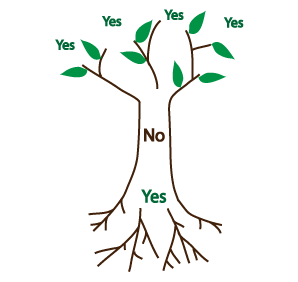Do You Need Help Saying ‘No’?
Do you cringe when you think about saying No to your boss, colleagues, friends or family? Do you already pride yourself on your toughness and ability to say No but find it creates tension sometimes? In either case, you will benefit from the Yes-No-Yes negotiation strategy in William Ury’s book, “The Power of a Positive No: How to say no and still get to yes” (http://www.williamury.com/books/power-of-a-positive-no). Since I read it a year ago, I find myself returning to his ideas again and again. So, I’m devoting this entire post to sharing a few key points from the book that I hope you will find useful too.
The basic concept is simple and easy to remember:
- Say YES to what you value.
- Say NO to the thing that threatens what you value.
- Say YES to what you are willing to do; offer options.
The bottom line is this: you can’t say Yes to everything. There’s simply not enough time in the day, or year, or your life to do everything you want, let alone the things others ask you to do. You’ve got to make choices and prioritize what’s most important. Clearly, this means you’ve got to say No sometimes. So why do you find yourself saying Yes to requests that aren’t in your best interest? Do they matter more because they come from your boss or your best friend — or do you simply feel bad saying No? What do you do? Take a deep breath and focus inward! Consider this, you dilute your quality of life when you extend yourself too far. You risk losing what’s most important to you when you let others fill your work or home life with their priorities.

Here’s how Ury explains it.
For visual thinkers, picture a tree:
- The roots represent a Yes to what you value –your deeply held beliefs and needs.
- Your firm No is the tree trunk rooted in your deeply held beliefs.
- The tree branches extending in many directions from the trunk are the many possible Yeses — the alternatives you propose.
Another way to remember it: A Positive No is “Yes! No. Yes?” Confused? Here’s how it works.
1. Express your Yes! One of the challenges is discovering what matters most to you and then making it your first priority. For example, does your family come first? You may need to say No to additional work, or requests from friends, or the myriad other things that are asked of you — because you know that your first priority is spending more time with your family.
2. Assert your No. You can be more confident in asserting your No when you have a Plan B. If Plan A is the path to agreement or acceptance, then Plan B is your backup. You don’t need anyone’s cooperation or agreement to put your Plan B in effect. It’s your alternative to negotiating an agreement. Remember, you don’t need to tell the other person your Plan B; after all, it’s not meant to be a threat. It’s your way of thinking through all the possibilities and giving yourself the confidence that your needs can be met. The key to saying No successfully is to express your needs and interest without sounding needy or desperate.
3. Propose/Negotiate a Yes? My favorite tip from Ury’s book, and the one I use most often, is to replace “But” with “Yes…and.” It shifts your perspective from a negative either-or stance to a positive problem-solving mode, and it avoids the word “but” (which gets people’s defenses up). The other person has a point, and so do you. For example, a hiring manager tells you the salary you have requested is high. You respond, “Yes, the salary I’m requesting is high and it’s appropriate for the value you agreed I would bring to the organization. And it’s aligned with the market rate.” You are agreeing with their assertion, and by using “and” rather than “but” you are providing reasons without being argumentative.
Here’s how Ury’s process has worked for me:
My scenario: I decided to reduce my work hours this summer to make more time for my family. I was saying Yes to what mattered most to me — my family (the tree roots). Besides asking to work less, I was firmly saying No to my own bad habit of habitually working late (the tree trunk). I thought hard about different options — Plans A, B, C (the tree branches) — and then I spoke with my manager. She readily agreed with my proposal. It was a win-win for both of us: my healthy work-life balance showed in my energetic, positive attitude and devotion to my work (and appreciation of my thoughtful manager!). Coming up with more than one proposal allowed me to think more broadly about my situation. I realized I could be flexible without giving up my primary need of having more time with my family.
“A ‘No’ uttered from deepest conviction is better and greater than a ‘Yes’ merely uttered to please, or what is worse, to avoid trouble.” — Mahatma Gandhi
Now It’s Your Turn
I highly recommend reading the book. In the meantime, print out Ury’s tips to empower yourself to say No: Three Steps to a Positive No (https://www.williamury.com/files/PositiveNoTips.pdf)
Video of William Ury talking about his book.
Leslie recommends this related article on influencing decision makers. Marshall Goldsmith, Effectively Influencing Decision Makers (http://www.businessweek.com/managing/content/jun2009/ca20090619_923770.htm)
